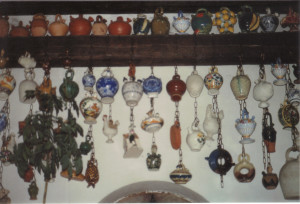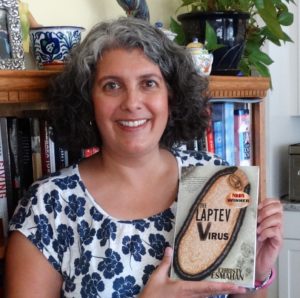 Being the only foreigner in a small city, and a student, had its advantages. I was especially lucky that all of the women who lived in my dorm saw it as their imperative to “educate me” in the ways of Spain. Thus, when we weren’t touring the country-side, my dorm-mates often took me out on the town. We went to an area of León aptly named “El Barrio Húmedo” (the moist neighborhood) where there were tons of bars and a very dynamic night life.
Being the only foreigner in a small city, and a student, had its advantages. I was especially lucky that all of the women who lived in my dorm saw it as their imperative to “educate me” in the ways of Spain. Thus, when we weren’t touring the country-side, my dorm-mates often took me out on the town. We went to an area of León aptly named “El Barrio Húmedo” (the moist neighborhood) where there were tons of bars and a very dynamic night life.
When you go to a bar in Spain you rarely ever get what an American would consider a full-sized glass of wine or beer. Instead you get a modest-sized glass (roughly half a bottle) of beer (called a caña, see my blog, “Una Cerveza, Por Favor,”) or you get about an inch of beer in a juice-sized glass, (called a corto.) And you get a tapa, a savory bite to eat, with your drink. In this manner you can go bar-hopping (because it’s simply unheard of to have more than one drink at a particular bar) and still be quite sober by the end of the night. Or, maybe, just a little tipsy at most.
Many smaller Spanish bars, especially those in El Barrio Humedo, would specialize in just one kind of tapa, and consequently gained fame (or notoriety) for the food they served. So, there was the place that gave you a steaming cup of sopa de ajo (garlic soup with parsley and bread floating in it) which we often went to first as we’d be pretty cold after walking all the way to this part of town and the soup would warm our fingers as we held the cup. Then there was the bar that served patatas bravas, perfectly fried cubes of potatoes sprinkled with just enough salt and spicy paprika to make you want to wash it down with your cold beer. There was a place that served chorizo, the typical Spanish sausage, cooked in white wine and served over crusty bread, (my mouth waters as I write this) and another one that served morcilla, blood sausage, which sounds horrible in English, so I always think of it in Spanish as it tastes amazingly good. And there’s another one that specializes in tortilla de patata, the Spanish potato omelet that is one of the best culinary inventions ever, and other tortillas (all omelets—not anything to do with Latin American tortillas that we are used to in the US.)
Back to my story: this particular night, the women (most were undergraduates, making them 1-4 years younger than me) had decided that my Spanish vocabulary lacked tacos. No, I’m not referring to the Taco-Bell kind: in Spain, a taco means a cuss word. Somehow in all the years of Spanish I had taken, none of my teachers had remembered to teach us how to swear. And, well, even if they had, I would still have needed this “class” that my dorm-mates had contrived because the Spanish have a whole different set of vocabulary words and expression than do the Latin Americans when it comes to cursing.
So here I was, out with this huge group of women, all of whom were swearing loudly, (making me repeat their words to be sure I had the exact intonation,) as we walked down the moist, cobble-stoned streets. It was cold and dark and we had already visited 6 bars, and, yes, I was beginning to get a bit tipsy when we got to the 7th bar, one that specialized in a type of sea-food called pulpo.
You have to understand that I grew up in land-locked Ohio, where the closest I got to sea-food was Mrs. Paul’s fish sticks, or the blue gills that my grandpa was so fond of fishing. So, with the room just barely beginning to drift and with the loud chorus of crazy women, and my 7th corto in one hand, I reached for the plate of tapas they were handing to me and I realized that I didn’t recognize what it was that they were offering me.
“Pruebalo, te gustará” Try it, you’ll like it. What, did they think I was Mikey? Neatly arranged on a wooden dish were little white pieces of something medallion shaped, kind of like a scallop, but sporting a maroon-colored ring around it. They were drizzled with olive oil and fresh paprika was sprinkled on top.
“But, what is it?” I asked, examining the speared white flesh on the end of my fork and they repeated the same nonsensical word they had said before: pulpo.
Pulpo, pulpo, pulpo—I ran it through my tired brain but no cigar.
“Viven en el mar”—they live in the ocean. Okay, that narrows it down—not! I still couldn’t think of anything that looked like that. A fish would have had bones…
Well, I reasoned, I’ve liked everything else we’ve had tonight, so what can it hurt? They huddled around me, watching as I popped it in my mouth, and… I found that I really liked it. A bit chewy, perhaps, but definitely a nice taste. Although it was certainly not anything I’d ever tasted before.
Pulpo.
“Does it swim?”
“Kind of. These are small ones that hunt among the rocks in the shallower seas north of us, in Galicia.”
Pulpo. This guessing game was getting long and I really wanted to know what it was. I took another swig of beer.
“It has 8 legs,” one of the women said.
Okay, now they were putting me on! I had studied plenty of biology and there were no fish with 8 legs! Maybe this was from some sort of lobster or other crustacean that had been peeled? Didn’t they have tons of little legs?
“Does it have a shell?” I asked. No, no shell. I took another sip of beer and popped another piece of pulpo into my mouth, feeling like there was something very obvious that I was missing in this equation.
“Creo que se dice (I think it’s called) oc-TOW-poos en ingles (in English.)”
And suddenly the coin dropped. Oh my goodness! I had been eating—no!—but 8 legs—it had to be! Octopus! Oh my goodness! My mind was racing and the room was eerily still—I remember that moment so clearly! Had I known that it was octopus I would certainly never have put it into my mouth. But…well, now that I thought of it…it had tasted very nice. Hmm. After hesitating for another moment, I made the decision that it was too late—I couldn’t object now because I already liked it!
For good measure I shouted out some of my newly acquired expletives, which everyone found hilarious, ordered a second, or should I say, 8th, corto, and popped another piece of pulpo into my mouth. Any wonder I have such fond memories of the place?!
If you enjoyed this blog post, you might also like my series of novels, Bueno, Sinco and Brujas, which takes place in Santander, Spain.



2 comments
Delightful! I felt like I was right there with you. 😉
Author
Thank you, Kathryn! 🙂